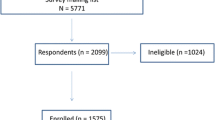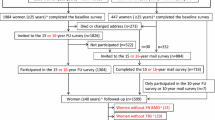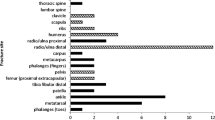Abstract
We examined the impact of degenerative conditions in the spine (osteophytosis and endplate sclerosis) and aortic calcification in the lumbar region on bone mineral content/density (BMC/BMD) measured in the spine and forearm by absorptiometry and on fracture risk prediction. The radiographs of 387 healthy postmenopausal women, aged 68–72 years, were assessed in masked fashion for the presence of osteophytosis, endplate sclerosis and aortic calcification in the region from L2 to L4. Vertebral deformities/fractures were assessed by different definitions. Osteophytes larger than 3 mm and in numbers of 3 or more resulted in a significantly (12%) higher spinal bone mass (p<0.001). Endplate sclerosis had a similar effect (p<0.001). In subjects with both degenerative conditions the BMC/BMD in the spine and forearm were significantly higher than in unaffected women (19% in the spine, 10% in the forearm;p<0.001). The spinal BMD values were significantly lower in fractured women if both degenerative conditions were absent (p<0.001), whereas fractured and unfractured women had similar values if degenerative conditions were present. Degenerative conditions did not alter the ability of forearm BMC to discriminate vertebral or peripheral fractures. Receiver operating characteristic (ROC) curves (true positive fraction versus false positive fraction) were generated for BMD of the lumbar spine and BMC of the forearm with regard to the discrimination between women with vertebral and peripheral fractures and healthy premenopausal women. The ROC curves for women without degenerative conditins were consistently above the curves for women affected by osteophytosis and endplate sclerosis in the lumbar spine (p<0.001). In conclusion, osteophytes and endplate sclerosis have a considerable influence on spinal bone mass measurements in elderly postmenopausal women and affect the diagnostic ability of spinal scans to discriminate osteoporotic women. Our data suggest that in elderly women, unless the spine is radiologically clear of degenerative conditions, a peripheral measurement procedure should be considered an alternative for assessment of bone mineral content/ensity.
Similar content being viewed by others
References
Parfitt AM. Physiological and clinical significance of bone histomorphometric data. In: Recker RR, editor. Bone histomorphometry: techniques and interpretation. Boca Raton: CRC Press, 1983:143–223.
Melton LJ III. Epidemiology of fractures. In: Riggs BL, Melton LJ III, editors. Osteoporosis: etiology, diagnosis and management. New York: Raven Press, 1988:133–54.
Wasnich RD, Davis JW, Ross PD. Spine fracture risk is predicted by non-spine fractures. Osteoporosis Int 1994;4:1–5.
Orwoll ES, Oviatt SK, Mann T. The impact of osteophytic and vascular calcifications on vertebral mineral density measurements in men. J Clin Endocrinol Metab 1990;70:1202–7.
Drinka PJ, DeSmet AA, Bauwens SF, Rogot A. The effect of overlying calcification on lumbar bone densitometry. Calcif Tissue Int 1992;50:507–10.
Reid IR, Evans MC, Ames R, Wattie DJ. The influence of osteophytes and aortic calcification on spinal mineral density in postmenopausal women. J Clin Endocrinol Metab 1991;72:1372–4.
Masud T, Langley S, Wiltshire P, Doyle DV, Spector TD. Effect of spinal osteophytosis on bone mineral density measurements in vertebral osteoporosis. BMJ 1993;307:172–3.
Dawson Hughes B, Dellal GB. Effect of radiographic abnormalities on rate of bone loss for the spine. Calcif Tissue Int 1990;46:280–1.
Lie JT. The structure of the normal vascular system and its reactive changes. In: Jüergens JL, Spittell JA Jr, Fairbaim JF, editors. Peripheral vascular diseases. Philadelphia: Saunders 1980:65.
Silver MD. Cardiovascular pathology. New York: Churchill Livingstone, 1983:252.
Overgaard K, Hansen MA, Riis BJ, Christiansen C. Discriminatory ability of bone mass measurements (SPA and DEXA) for fractures in elderly postmenopausal women. Calcif Tissue Int 1992;50:30–5.
Kleerekoper M, Parfitt AM, Ellis BI. Measurement of vertebral fracture rates in osteoporosis. In: Osteoporosis: proceedings of the International Symposium on Osteoporosis. Copenhagen, Denmark: Aalborg Stiftsbogtrykkeri, 1984:103–9.
Melton LJ III, Kan SH, Frye MA, Wahner HW, O'Fallon WM, Riggs BL. Epidemiology of vertebral fractures in women. Am J Epidemiol 1989;129:1000–11.
Hansen MA, Hassager C, Overgaard K, Marslew U, Riis BJ, Christiansen C. Dual-energy X-ray absorptiometry: a precise method of measuring bone mineral density in the lumbar spine. J Nucl Med 1990;31:1156–62.
Nilas L, Borg J, Gotfredsen A, Christiansen C. Comparison of single- and dual-photon absorptiometry in postmenopausal bone mineral loss. J Nucl Med 1985;26:1257–62.
Metz CE. Basic principles of ROC analysis. Semin Nucl Med 1978;8:283–98.
McNeil BJ, Keeler E, Adelstein SJ. Primer on certain elements of medical decision making. N Engl J Med 1975;293:211–5.
Hanley JA, McNeil BJ. The meaning and use of the area under a receiver operating characteristic (ROC) curve. Radiology 1982;143:29–36.
Hanley JA, McNeil BJ. A method of comparing the areas under receiver operating characteristic curves derived from the same cases. Radiology 1983;148:839–43.
Resnick D, Niwayama G. Degeneration disease of the spine. In: Resnick D, Niwayama G, editors. Diagnosis of bone and joint disorder. Philadelphia: Saunders, 1981:1374–80.
Pouilles JM, Tremollieres F, Louvet JP, Fournie B, Morlock G, Ribot C. Sensitivity of dual-photon absorptiometry in spinal osteoporosis. Calcif Tissue Int 1988;43:329–34.
Cummings SR. Are patients with hip fracture more osteoporotic? Review of the evidence. Am J Med 1985;78:487–94.
Gotfredsen A, Pødenphant J, Nilas L, Christiansen C. Discriminatory ability of total body bone-mineral measured by dual photon absorptiometry. Scand J Clin Lab Invest 1989;49:125–34.
Gevers G, Dequeker J, Geusens P, Nyssen-Behets C, Dhem A. Physical and histomorphological characteristics of iliac crest bone differ according to the grade of osteoarthritis at the hand. Bone 1989;10:173–7.
Roh YS, Dequeker J, Mulier JC. Cortical bone remodeling and bone mass in primary osteoarthritis of the hip. Invest Radiol 1973;8:251–4.
Wientroub S, Papo J, Ashkenazi M, Tardiman R, Weissman SL, Salama R. Osteoarthritis of the hip and fractures of the proximal femur. Acta Orthop Scand 1982;53:261–4.
Dequeker J. The relationship between osteoporosis and osteoarthritis. Clin Rheum Dis 1985;11:271–96.
Banks LM, Lees B, Macsweeney JE, Stevenson JC. Effect of degenerative spinal and aortic calcification on bone density measurements in post-menopausal women: links between osteoporosis and cardiovascular disease? Eur J Clin Invest 1994;24:813–7.
Bjarnason K, Hassager C, Ravn P, Christiansen C. Early postmenopausal diminution of forearm and spinal bone mineral density: a cross-sectional study. Osteoporosis Int 1995;5:35–8.
Author information
Authors and Affiliations
Rights and permissions
About this article
Cite this article
von der Recke1, P., Hansen, M.A., Overgaard, K. et al. The impact of degenerative conditions in the spine on bone mineral density and fracture risk prediction. Osteoporosis Int 6, 43–49 (1996). https://doi.org/10.1007/BF01626537
Received:
Accepted:
Issue Date:
DOI: https://doi.org/10.1007/BF01626537




